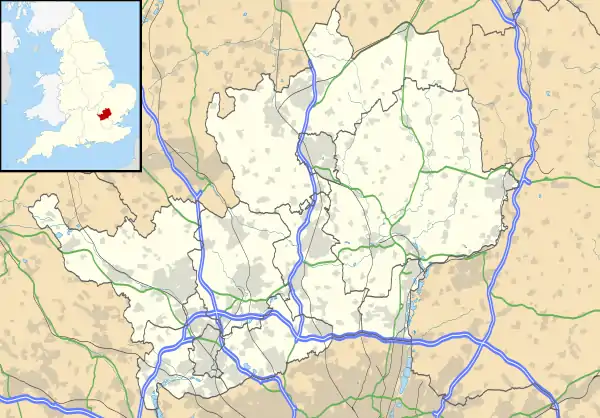St Ippolyts
St Ippolyts (or St Ippollitts) is a small village and civil parish on the southern edge of Hitchin in Hertfordshire, England. It has a population of approximately 2,000.
| St Ippolyts | |
|---|---|
.jpg.webp) St Ippolyts village green | |
 St Ippolyts Location within Hertfordshire | |
| Population | 2,047 (2011 Census including Gosmore)[1] |
| OS grid reference | TL197270 |
| District | |
| Shire county | |
| Region | |
| Country | England |
| Sovereign state | United Kingdom |
| Post town | Hitchin |
| Postcode district | SG4 |
| Dialling code | 01462 |
| Police | Hertfordshire |
| Fire | Hertfordshire |
| Ambulance | East of England |
| UK Parliament | |
Geography
St Ippolyts is located in between the A602 (Stevenage Road) and the B656 (Codicote Road), 2 km (1.2 mi) south-east of Hitchin, Hertfordshire. It lies approximately 80 m (260 ft) above sea level in a gap in the Chiltern Hills.
Some features of the village are a 17th-century gabled house, a timber-framed house formerly known as the Olive Branch Inn, and a 16th-century house built around an even older timbered house.
History
The name of St Ippolyts, although spelled in a variety of ways, is derived from St Hippolytus to whom the village church was dedicated. According to Daphne Rance in her book on the parish "St. Ippolyts: a country parish in the nineteenth century" (1987) at various times also known as Epolites, Pallets, Nipples or St Ibbs. In the same vein, the 1881 census mentions the following 28 place names, all of which are believed to refer to it: Iplits, Ipolits, Ipollitts, Ipollyts, Ipolytes, Ipolyts, Ippatyts, Ipplits, Ipployts, Ipplyts, Ippolett, Ippoletts, Ippolits, Ippolitss, Ippolits, Ippolitss, Ippolitts, Ippollit, Ippollits, Ippollitts, Ippollyts, Ippollytts, Ippololits, Ippolts, Ippolytis, Ippolyts, Ippolytts, Ippoplitts.
St Ippolyts Church

The church was built in 1087 in a beautiful setting on the hillside above the village. According to the church records, the building was funded by grants supplied by Judith de Lens, the niece of William the Conqueror. De Lens gave evidence against her husband, a Saxon Earl, which led to his execution. The funding of the church was an attempt to make amends for this act. The church was rebuilt in the mid nineteenth century using old materials 'recycled' from the nearby abandoned Minsden Chapel. Apart from St Ippolyts, the church also serves the nearby villages of Gosmore and Langley.
The noted theologian Fenton John Anthony Hort (Fenton Hort) is amongst the former vicars of St Ippolyts church where he stayed for 15 years before taking up a fellowship and lectureship at Emmanuel College in Cambridge .
Politician George Lloyd, 1st Baron Lloyd (1879-1941) was buried in the churchyard.[2]
Almshoe
The ancient manor[3] of Almshoe, mentioned in the Domesday Book,[4] is located in the south of the parish. Almshoe Bury—now a farmhouse and wedding venue—is a grade I listed building.[5]
Nearby towns and villages
- Gosmore
- Great Wymondley
- Hitchin
- Kings Walden
- Little Wymondley
- Preston
- Stevenage
References
- "Civil Parish population 2011". Neighbourhood Statistics. Office for National Statistics. Retrieved 29 October 2016.
- Oxford Dictionary of National Biography, Volume 34. Oxford University Press. 2004. p. 127.
- http://www.british-history.ac.uk/vch/herts/vol3/pp25-28
- http://opendomesday.org/place/XX0000/almshoe-bury-and-little-almshoe/
- https://www.britishlistedbuildings.co.uk/101102513-almshoe-bury-st-ippolyts